Full Text: Energy in China's New Era
Energy in China's New Era
The State Council Information Office of
the People's Republic of China
December 2020
Contents
Preamble
I. Developing High-Quality Energy in the New Era
II. Historic Achievements in Energy Development
III. An All-Round Effort to Reform Energy Consumption
IV. Building a Clean and Diversified Energy Supply System
V. Leveraging the Role of Innovation as the Primary Driver of Development
VI. Deeper Reform of the Energy System in All Areas
VII. Strengthening International Energy Cooperation Across the Board
Conclusion
Preamble
Energy is the foundation and driving force for the progress of human civilization. It matters to the economy, to people's lives, to national security, and to the survival and development of humanity. It is of vital importance in advancing social and economic development and public welfare.
Since the founding of the People's Republic of China (PRC) in 1949, under the leadership of the Communist Party of China (CPC), a relatively complete energy industry system has been established. This has largely been achieved through self-reliance and hard work. Since the launch of the reform and opening-up policy in 1978, to adapt to the rapid development of the economy and society, China has promoted the development of energy in a comprehensive, coordinated and sustainable manner. Today, China has become the world's largest energy producer and consumer. Its transition to efficient energy utilization has been the fastest in the world.
Since the 18th CPC National Congress in 2012, China has entered a new era, as has its energy development. In 2014, President Xi Jinping put forward a new energy security strategy featuring Four Reforms and One Cooperation, pointing out the direction for the quality growth of the energy industry with Chinese characteristics in the new era. China upholds the vision of innovative, coordinated, green, open and shared development with focus on high quality and restructuring of the supply side. It has been working on all fronts to reform the ways energy is consumed, to build a clean and diversified energy supply system, to implement an innovation-driven energy strategy, to further the reform of the energy system, and to enhance international energy cooperation. China has entered a stage of high-quality energy development.
A thriving civilization calls for a good eco-environment. Facing increasingly severe global problems such as climate change, environmental risks and challenges, and energy and resource constraints, China embraces the vision of a global community of shared future and accelerates its transformation towards green and low-carbon development in economy and society. In addition to promoting clean and low-carbon energy use domestically, China has been an active participant in global energy governance, exploring a path of worldwide sustainable energy alongside other countries. At the general debates of the 75th United Nations General Assembly in September 2020, President Xi pledged that China will scale up its Intended Nationally Determined Contributions by adopting more vigorous policies and measures, striving to have carbon dioxide emissions peak before 2030 and to achieve carbon neutrality before 2060. In the new era, China's energy strategy will provide forceful support for sound and sustained economic and social development, and make a significant contribution to ensuring world energy security, addressing global climate change, and boosting global economic growth.
The Chinese government is publishing this white paper to provide a full picture of China's achievements in its energy development and its major policies and measures for energy reform.
I. Developing High-Quality Energy in the New Era
China's energy strategy in the new era endeavors to adapt to domestic and international changes and meet new requirements. China will continue to develop high-quality energy to better serve economic and social progress, support the Beautiful China and Healthy China initiatives, and build a clean and beautiful world.
1. The New Energy Security Strategy
In its energy plans for the new era, China has adopted a new strategy featuring Four Reforms and One Cooperation.
– One reform to improve the energy consumption structure by containing unnecessary consumption. China is determined to carry out the principle of prioritizing energy conservation, and has tightened the control of total energy consumption and energy use intensity, and enforced energy conservation in all areas of social and economic development. It resolves to adjust its industrial structure. It emphasizes energy conservation in the process of urbanization, and works to develop a green and low-carbon transport system. China encourages hard work and thrift and calls people to conserve energy and work and live with green energy, and move faster towards an energy-saving society.
– One reform to build a more diversified energy supply structure. In the direction of green development, China has been vigorously promoting the clean and efficient utilization of fossil energy, prioritizing the development of renewable energy, developing nuclear power in a safe and orderly manner, and raising the proportion of non-fossil energy in the energy supply structure. China has intensified efforts for the exploration and exploitation of oil and gas resources, to increase reserve and production volumes. China has been building the production, supply, storage and sales systems for coal, electricity, oil and gas, while improving energy transportation networks, storage facilities, the emergency response system for energy storage, transportation and peak load management, and enhancing its supply capacity for safer and higher-quality energy.
– One reform to improve energy technologies to upgrade the
industry. China is implementing the innovation-driven development strategy, building a system that nurtures innovation in green energy technologies, and upgrading energy technologies and equipment in an all-round
way. China has strengthened basic research on energy, innovation in generic and disruptive technologies, and original and integrated innovation. China has started to integrate digital, big-data and AI technologies with technologies for clean and efficient energy exploration and exploitation, with a focus on smart energy technologies, to turn these technologies and related industries into new growth drivers for industrial upgrading.
– One reform to optimize the energy system for faster growth of the energy sector. China is determined to promote energy market reform, to marketize energy commodities and form a unified and open market with orderly competition. China is furthering energy pricing reform, to create a mechanism in which the market determines the price. China has been working to modernize its law-based energy governance system, developing new models of efficient energy management, and pushing forward reforms to streamline government administration, delegate powers, improve regulation, and upgrade service. It has strengthened planning and policy guidance for the energy sector, and improved the regulatory system of the energy industry.
– Comprehensive cooperation with other countries to realize energy security in an open environment. Under the principle of equality and mutual benefit, China is opening its door wider to the world. China promotes green and sustainable energy under the Belt and Road Initiative (BRI), and endeavors to improve energy infrastructure connectivity. China
has been an active participant in global energy governance, increasing
energy cooperation and exchanges with other countries, and facilitating international trade and investment in the energy sector. China has joined the international community in building a new model of energy cooperation, maintaining energy market stability, and safeguarding common
energy security.
2. Guiding Philosophies for Energy Policies in the New Era
– Putting people first. China upholds the principle of energy development for the people, by the people and answerable to the people. Its primary goal is to ensure energy supply for people's life and to ensure that the poverty-stricken population have access to electricity. To this end, China has been improving energy infrastructure related to people's life and public services, and has integrated energy development with poverty eradication. China has launched programs on poverty reduction through energy support, which exemplify the fundamental role of energy supply, infrastructure and services in the battle against poverty.
– Promoting a clean and low-carbon energy. China embraces the vision of harmonious coexistence between humanity and nature, directing its efforts towards clean and low-carbon energy. China promotes green energy production and consumption, and has improved the relevant structures accordingly. China is increasing the proportion of clean energy and non-fossil energy at the consumption stage, reducing carbon dioxide emissions and pollutant discharge by large margins, and working hard to accelerate its transformation towards green and low-carbon development for the Beautiful China initiative.
– Ensuring the core status of innovation. China is focusing on transforming the energy sector through technical advancement. China is actively promoting independent innovation in energy technologies, and increasing sci-tech input in the national energy development. With enterprises playing a key role in innovation, China has been promoting close collaboration along the energy industrial chain between enterprises, universities and research institutes, to reduce technology imports and boost independent innovation so as to develop a new model where innovations of both upper and lower streams well interact and coordinate with each other.
– Pursuing development through reform. China will fully leverage the decisive role of the market in allocating energy resources, and ensure the government better play its part in this regard. It is endeavoring to
advance market-oriented reform in the competitive areas of the energy sector, further display the role of the market mechanism, and build a high-quality energy market system. China has highlighted the guiding role of
its energy strategy and planning, formed a law-based governance system and a regulatory system in the energy industry, and improved the financial and fiscal systems that support green and low-carbon energy transformation. All these measures aim to unlock potential and provide support for quality growth of the energy sector.
– Building a global community of shared future. Confronted by the severe impact of climate change, China advocates a global community of shared future, greater international cooperation on energy governance, and a new round of energy reform directed towards clean and low-carbon development. China has joined other countries in seeking sustainable energy and building a clean and beautiful world.
II. Historic Achievements in Energy Development
China is committed to driving an energy revolution. As a result, major changes have taken place in the production and use of energy and historic achievements have been realized in energy development. Energy production and consumption are being optimized, energy efficiency has increased significantly, and energy use has become more convenient for both work and life. China's capacity to ensure energy security has been strengthened. All this provides important support to quality economic development, victory in the battle against poverty, and building a moderately prosperous society in all respects.
1. Growing Capacity to Ensure Energy Supply
A diversified energy production infrastructure consisting of coal, oil, natural gas, electricity, nuclear energy, new energy and renewable energy is in place. Preliminary calculations show that China's primary energy production in 2019 reached 3.97 billion tons of standard coal, making it the world's largest energy producer.
Coal remains the basic energy source. Since 2012, the annual production of raw coal has ranged between 3.41 and 3.97 billion tons. Crude oil production remains stable. Since 2012, the annual production of crude oil has ranged between 190 and 210 million tons. The production of natural gas has increased notably, from 110.6 billion cu m in 2012 to 176.2 billion cubic meters in 2019. China's electricity supply capacity has risen to a cumulative installed capacity of 2.01 billion kW in 2019, up 75 percent since 2012, and an electricity output of 7.5 trillion kWh, up 50 percent. Renewable energy resources have expanded rapidly, with cumulative installed capacities of hydropower, wind power, and solar photovoltaic (PV) power each ranking top in the world. As of the end of 2019, the total installed capacity of nuclear power plants under construction and in operation reached 65.93 million kW, the second largest in the world. The installed capacity of nuclear power plants under construction ranked first.
Energy transport capacity has risen remarkably. China has built natural gas trunk lines measuring over 87,000 km, oil trunk lines totaling 55,000 km, and 302,000 km of electricity transmission lines of 330 kv or more.
The energy reserve system has been steadily improved. China has built nine national oil reserve bases; it has achieved preliminary results in building a natural gas production, supply, reserve and sale system; the coordinated guarantee system for coal production and transport is sound; the country has become a global leader in operating a secure and stable power grid; and its capacity in comprehensive energy emergency response has been strengthened significantly.

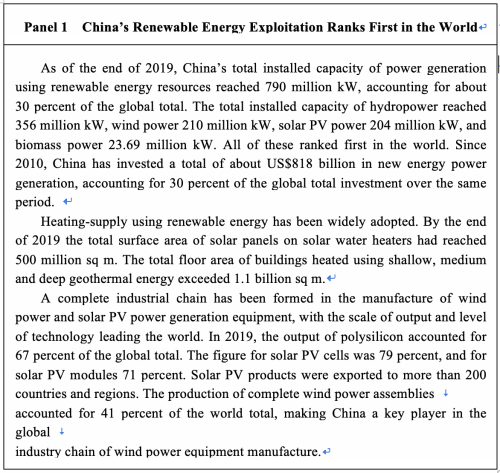
2. Remarkable Achievements in Optimizing Energy Conservation and Consumption
Significant improvement has been made in energy efficiency. Since 2012, energy consumption per unit of GDP has been reduced by 24.4 percent, equivalent to 1.27 billion tons of standard coal. From 2012 to 2019, China saw an average annual growth of 7 percent in the economy, while annual energy consumption rose by only 2.8 percent.
The shift towards clean and low-carbon energy consumption is accelerating. Preliminary calculations show that in 2019, coal consumption accounted for 57.7 percent of total energy consumption, a decrease of 10.8 percentage points from 2012; the consumption of clean energy (natural gas, hydropower, nuclear power, wind power) accounted for 23.4 percent of total energy consumption, an increase of 8.9 percentage points over 2012. Non-fossil energy accounted for 15.3 percent of total energy consumption, up 5.6 percentage points against 2012. With this China has reached the target of raising the share of non-fossil energy to 15 percent in total energy consumption by 2020. The number of new energy vehicles is rising rapidly. In 2019 the total number of new energy vehicles reached 3.8 million, with 1.2 million new energy vehicles going on road that year. Both of these figures represent more than half of the global totals. As of the end of 2019, there were 1.2 million electric-vehicle charging stations nationwide, constituting the largest charging network in the world, and effectively improving energy efficiency and optimizing energy consumption in the transport sector.
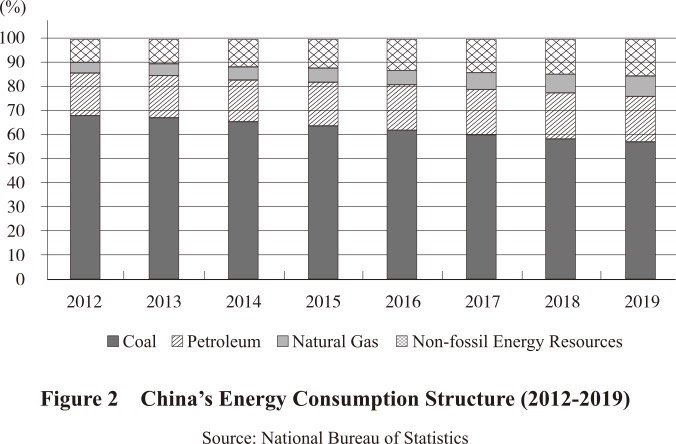
3. Rapid Improvements in Energy Technology
China continues to pursue technological innovation in the energy sector. Its energy technologies are continuously improving, and technological progress has become a basic driver for the transformation of the energy industry. There are complete industrial chains for the manufacturing of clean energy equipment for hydropower, nuclear power, wind power, and solar power. China has successfully developed and manufactured the world's largest single-unit hydropower generators, with a capacity of 1 million kW; it is able to manufacture a full range of wind turbines with a maximum single-unit capacity of 10 mw; and it continues to establish new world bests in the conversion efficiency of solar PV cells. China has built a number of nuclear power plants using advanced third-generation technologies, and made significant breakthroughs in a number of nuclear energy technologies such as new-generation nuclear power generation and small modular reactors. Its technological capabilities in oil and gas exploration and development keep improving. It leads the world in technologies such as the high-efficiency development of low-permeability crude oil and heavy oil, and a new generation of compound chemical flooding. The technology and equipment for shale oil and gas exploration and development have greatly improved, and successful natural gas hydrate production tests have been completed. China is developing green, efficient and intelligent coal mining technology. It has achieved mechanization in 98 percent of its large coal mines, and mastered the technology for producing oil and gas from coal. It has built a safe, reliable, and world-leading power grid which is the largest across the globe, with reliability of supply at the forefront of the world. A large number of new energy technologies, new businesses, and new models such as "Internet +" smart energy, energy storage, block chain, and integrated energy services are booming.
4. Significant Progress in Eco-Environmental Friendliness of the Energy Sector
China sees green energy as an important measure to enhance eco-environmental progress, and resolutely fights pollution, especially air pollution. Its capabilities in clean coal mining and utilization have greatly improved, and significant results have been achieved in regulating coal mining subsidence areas and building green mines. It has amended the Law on Air Pollution Prevention and Control to strengthen the prevention and control of pollution from coal and other energy sources, and ensure that more environmentally friendly energy sources are used to replace coal in equal or reduced amount in newly-built, renovated, or expanded coal-consuming projects in key areas for air pollution control. The green development of the energy sector has significantly improved air quality, and the emissions of sulfur dioxide, nitrogen oxides and soot have dropped notably. Green development of the energy sector has played an important role in reducing carbon emissions. By 2019, carbon emission intensity in China had decreased by 48.1 percent compared with 2005, which exceeded the target of reducing carbon emission intensity by 40 to 45 percent between 2005 and 2020, reversing the trend of rapid carbon dioxide emission growth.
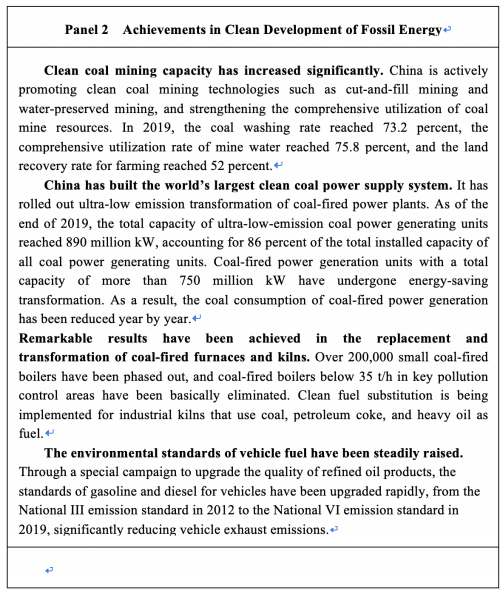
5. Continuous Improvement in the Energy Governance Mechanism
China is making every effort to ensure that the market plays a greater role in the energy sector. Now, in a better business environment and a more viable market, market entities and individuals enjoy more convenient services and find it easier to start businesses. Market access for foreign capital in the energy sector has been extended, private investment is growing, and investment entities have become more diverse. Policies on power generation and consumption plans have been relaxed in an orderly manner, trading institutions can operate independently and in accordance with regulations, and the power market has further developed. China has accelerated reforms such as the deregulation of the oil and gas exploration market and the circulation of mining rights, reform of the pipeline network operation mechanism, and the dynamic management of crude oil imports. It has improved the construction of oil and gas trading centers. China encourages the market to play a decisive role in determining energy prices. It has further relaxed control on the prices in competitive areas, and has preliminarily established a reasonable pricing mechanism for power transmission and distribution and oil and gas pipeline networks. It coordinates energy reform with law-based governance, and the legal framework regarding the energy sector has been improved. An energy governance mechanism covering strategies, plans, policies, standards, supervision, and services is in place.
6. Solid Benefits for People's Lives
Ensuring public wellbeing and improving people's lives is China's fundamental goal in energy development. China is ensuring that urban and rural residents have access to basic energy supply and services, as a fundamental element in building a moderately prosperous society in all respects and supporting rural revitalization. From 2016 to 2019, the total investment in transforming and upgrading rural power grids reached RMB830 billion, and the average power outage time in rural areas was reduced to about 15 hours per year. The quality of power services for rural residents has improved significantly. From 2013 to 2015 China implemented an action plan to ensure access to electricity for every citizen, and completed this historic task by the end of 2015. It has implemented poverty alleviation projects based on solar PV power generation, and other energy-related poverty alleviation projects. China prioritizes poverty-stricken areas in planning energy development projects and has introduced energy projects for the benefit of the rural residents. This has promoted economic development in poverty-stricken areas and raised the incomes of the poor. It has improved the infrastructure for natural gas utilization, supplied natural gas to more areas, and improved its ability to ensure gas supply for people's daily life. Significant progress has been made in clean heating in northern China, with improvements in the energy use and living environment of urban and rural residents. As of the end of 2019, clean heating in northern China covered a floor space of 11.6 billion sq m, an increase of 5.1 billion sq m over 2016.
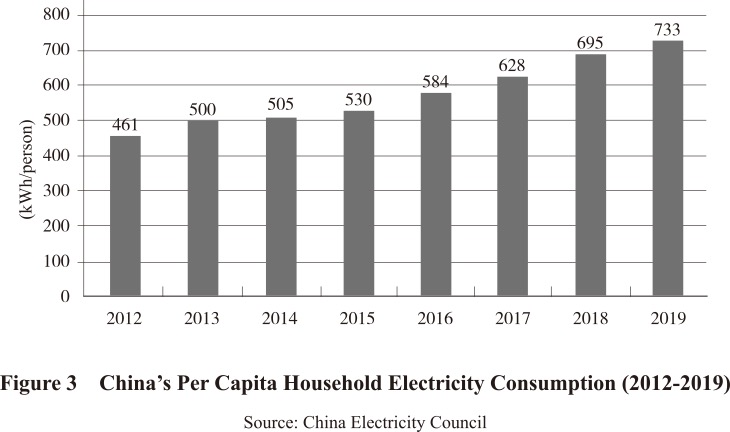
III. An All-Round Effort to Reform Energy Consumption
China perseveres with its fundamental national policy of conserving resources and protecting the environment. Prioritizing energy saving, it understands that energy conservation means increasing resources, reducing pollution, and benefiting humanity, and exercises energy saving throughout the whole process and in all areas of economic and social development.
1. Implementing a Dual Control System of Total Energy Consumption and Energy Intensity
A dual control system of total energy consumption and energy intensity is in place. China sets the targets of total energy consumption and energy intensity for different provinces, autonomous regions and municipalities directly under the central government and applies oversight and checks over the performance of local governments at all levels. It has introduced the energy-saving index into the performance evaluation system of eco-environmental progress and green development, to guide the transformation of the development philosophy. It breaks down the dual control targets of total energy consumption and energy intensity for key energy consumers, and evaluates their performance accordingly to strengthen energy-saving management.
2. Improving Laws, Regulations and Standards for Energy Conservation
China has revised the Energy Conservation Law. It has put in place an energy-saving system in key areas including industry, construction and transport as well as in public institutions. It continues to improve the supporting legal institutions for energy conservation supervision, energy-efficiency labeling, energy-saving checks on fixed assets investment projects, and energy conservation management of key energy consumers. It has strengthened standard-setting as a constraining factor and improved energy-saving standards system. It has carried out 100 projects to upgrade energy efficiency standards, enacted more than 340 national energy-saving
standards, including almost 200 mandatory standards, covering most high energy-consuming industries and final energy consumption products. China has strengthened oversight over energy-saving law enforcement, reinforced operational and post-operational supervision, and exercised strict accountability for law enforcement to ensure the effective implementation of energy conservation laws, regulations, and mandatory standards.
3. Improving Energy-Saving and Low-Carbon Incentives
Corporate income tax and value-added tax incentives are awarded to energy-saving businesses. China encourages the imports of energy-saving technologies and equipment, and controls the exports of energy-intensive and heavy-polluting products. China is improving the green financial system, and makes use of energy efficiency credits and green bonds to support energy conservation projects. It is exploring new ground in pricing to advance green development. Differential pricing, time-of-use pricing, and tiered pricing for electricity and natural gas have been adopted. China is improving its policies of environment-friendly electricity pricing to arouse the enthusiasm of market entities and the public in energy conservation. It has conducted trials of paid use of and trading in energy-using right in four provinces and cities including Zhejiang, and carbon emissions trading in seven provinces and cities including Beijing. The government is promoting energy performance contracting (EPC) and developing integrated energy services, and encourages innovations in energy-saving technology and business models. It has strengthened the management of demand-side power use and implemented a market response mechanism to guide the economical, orderly and rational utilization of electricity. A "leader board" of best energy-savers has been put in place to increase the efficiency of final energy consumption products, energy-intensive industries, and public institutions.
4. Improving Energy Efficiency in Key Areas
China is doing all it can to optimize the industrial structure, develop advanced manufacturing, high-tech industry and modern services with low energy consumption, and promote the intelligent and clean transformation of traditional industries. China has sped up the transformation to green, recycling and low-carbon industry, and implemented green manufacturing on all fronts; put in place monitoring, law enforcement and
diagnostic mechanisms for energy conservation, and carried out energy efficiency benchmarking; raised the energy-saving standards of new buildings, expanded the energy-saving renovation of existing buildings, and
improved the structure of energy consumption in construction. It is developing a highly efficient and comprehensive transport system with lower energy consumption, promoting the use of clean energy in transport, and enhancing energy efficiency of vehicles and other means of transport. It is building energy-saving public institutions, to set an example for the rest of society. A market-oriented system of green technology innovation will be put in place to encourage the R&D, transfer and popularization of green technology. China is promoting national key energy-saving and low-carbon technologies, particularly for the transport sector, and energy-saving industrial equipment. The government encourages extensive public involvement in energy conservation, and is raising public awareness of frugality, promoting simple, modest, green and low-carbon lifestyles, and opposing extravagance and excessive consumption.
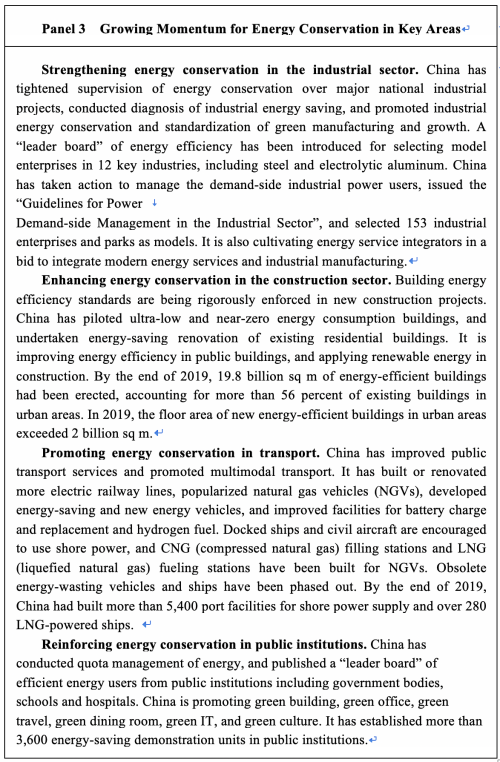
5. Promoting Clean Final Energy Consumption
Focusing on the Beijing-Tianjin-Hebei region and its surrounding areas, the Yangtze River Delta, the Pearl River Delta and the Fenwei Plain (the Fenhe Plain, the Weihe Plain and their surroundings in the Yellow River Basin), China is working to reduce and find substitutes for coal consumption, and taking comprehensive measures to control the use of bulk coal. It is promoting clean and efficient coal-fired furnaces, and replacing inefficient and highly-polluting coal with natural gas, electricity and renewable energy. Now, fiscal and price policies are in place to support clean heating in winter in northern China to improve air quality. China is replacing coal and oil with electricity in final energy consumption, and popularizing new energy vehicles, heat pumps, electric furnaces, and other new forms of energy consumption. It has strengthened the development and connectivity of natural gas infrastructure, and made the use of natural gas more efficient in urban areas, as well as in industrial fuel, power generation, and transport. It is promoting natural gas CCHP (combined cooling heating and power), decentralized renewable energy, and multi-energy coordination and energy cascade use in final energy consumption.
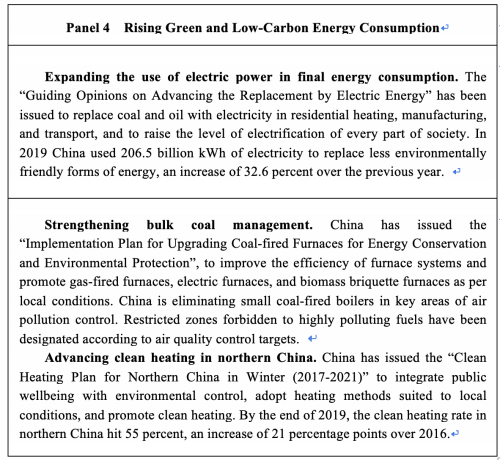
IV. Building a Clean and Diversified Energy Supply System
Proceeding from its basic national conditions and current stage of development, China gives priority to eco-environmental conservation and pursues green development. It seeks growth while protecting the environment, and believes that a sound eco-environment better facilitates growth. It focuses on supply-side structural reform in the energy sector – giving priority to non-fossil energy, promoting the clean and efficient development and utilization of fossil energy, improving the energy storage, transportation and peak-shaving system, and developing coordinated, complementary, and diverse energy sources in different regions.
1. Prioritizing Non-Fossil Energy
The development and utilization of non-fossil energy is a major element of transitioning to a low-carbon and eco-friendly energy system. China gives priority to non-fossil energy, and strives to substitute low-carbon for high-carbon energy and renewable for fossil energy.
Facilitating the use of solar energy. In line with the principles of driving technological progress, reducing costs, expanding the market and improving the system, China is promoting the use of solar energy in an all-round way. It makes overall planning of geographical layout of solar PV generation bases and market accommodation, with emphasis on both centralized and decentralized power generation. It has implemented a "leader board" incentive to encourage solar PV power generation, and allowed projects to be allocated through market competition, so as to accelerate progress in relevant technologies and reduce costs. As a result, China's solar PV industry has become internationally competitive. The country is improving grid access and other services for decentralized solar PV power generation, and coordinating the development of solar PV power, agriculture, animal husbandry, and desertification control to form a diversified model of solar PV power generation. China is also industrializing solar thermal power generation through demonstration projects, and providing market support for related industrial chains. It has expanded the market for and utilization of solar thermal energy, and introduced centralized hot water projects in industry, commerce and public services to pilot solar heating.
Developing wind power. On the basis of balancing wind power development with power transmission and accommodation, China is taking steps to exploit wind power and building large-scale wind power bases. Based on the principles of overall planning and coordination, and efficient utilization and development of centralized and decentralized wind power both onshore and offshore, it is taking active measures to develop decentralized wind energy in the middle and eastern parts of the country, and offshore wind farms. It gives priority to wind power projects that deliver electricity at affordable prices, and encourages project allocation through market-oriented competition. China also promotes wind power production through large-scale development and utilization of wind power, which helps to boost industry innovation and international competitiveness, and improve the industrial service system.
Developing green hydropower. China considers eco-environmental conservation to be a priority and pursues green development. While protecting the eco-environment and relocating the residents, China develops hydropower in a rational and orderly way, giving equal importance to development and conservation, and emphasizing on both the construction and consequent management of the facilities. Focusing on major rivers in the southwest, China is building large hydropower bases and controlling the construction of small and medium-sized hydropower stations in the basin areas. China seeks the green development of small hydropower stations, and has increased investment in river ecology restoration. It is also improving policies for relocated residents to share the benefits from hydropower projects, thus giving a boost to local economic and social development and helping the relocated population get out of poverty. As in any resource development program, the goals are always set for a better economy, better environment, and better benefits for the people.
Developing safe and structured nuclear power. Nuclear security is the lifeline in developing nuclear power. China attaches equal importance to safety and the orderly development of nuclear power. It has strengthened whole-life management and supervision of nuclear power planning, site selection, design, construction, operation, and decommissioning, and adopted the most advanced technologies and strictest standards for the nuclear power industry. China is improving the multilevel system of regulations and standards on nuclear energy and safety and strengthening relevant emergency plans, legal system, institutions and mechanisms, in its effort to establish a national emergency system that effectively responds to nuclear accidents. China has strengthened nuclear security and nuclear material control, rigorously fulfilling its international obligations towards nuclear security and non-proliferation, and keeping a good nuclear security record. So far, the nuclear power units in operation are generally safe, and there have been no incidents or accidents of level 2 or above on the International Nuclear and Radiological Event Scale.
Developing biomass, geothermal and ocean energy in accordance with local conditions. China is adopting advanced technologies that meet environmental protection standards to generate power by means of urban solid waste incineration, and upgrading biomass power generation to cogeneration of heat and power. It is growing biogas into an industry and transforming methane use in rural areas. In industrializing liquid bio-fuel production by means of non-food biomass, it avoids using crops as raw materials and occupying arable land, strictly controls the expansion of fuel ethanol processing capacity, and focuses on improving the quality of biodiesel products. China is engaged in innovative geothermal power generation, providing urban central heating, and building demonstration zones for efficient production and utilization. It is also reinforcing R&D and pilot demonstrations on harnessing ocean power such as tidal and wave energy.
Increasing the overall utilization rate of renewable energy. China guarantees full acquisition of all renewable energy generated. It has implemented a clean energy accommodation action plan and is adopting various measures to promote the use of clean energy. It is improving the overall planning of the power sector, optimizing the power supply structure and layout, and allowing the market to function as a regulator, to form institutional mechanisms conducive to the use of renewable energy and make the power system more flexible and better at coordinating energy use.
China has put in place a mechanism for accommodating power generated from renewable energy, which determines on an annual basis the minimum proportion of renewable energy to be consumed in each province and equivalent administrative unit, and requires suppliers and users to work together to achieve this goal. The country uses the power grid as a platform for optimizing resource allocation. It facilitates optimal interaction and coordination of power source-grid-load-storage, and improves the appraisal and supervision of different sectors in accommodating power generated from renewable energy. Renewable energy use rate has increased significantly: In 2019 the national average consumption rate of wind power was 96 percent, that of solar PV power was 98 percent, and that of water energy in major river basins reached 96 percent.
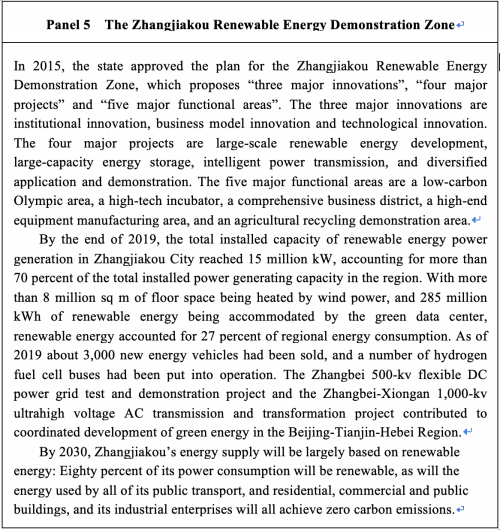
2. Promoting Clean and Efficient Development and Utilization of Fossil Energy
China coordinates the development and utilization of fossil energy and eco-environmental protection in accordance with its resource endowment and the bearing capacity of natural resources and the environment. It promotes advanced production capacity while phasing out outdated capacity. It also promotes the clean and efficient utilization of coal and the exploration and development of oil and gas, and works to increase reserves and production, so as to be more self-sufficient in oil and gas.
Facilitating the safe, smart and green utilization of coal. China strives to build an intensive, safe, efficient and clean coal industry. It is furthering supply-side structural reform in the industry, improving the coal production capacity replacement policy, speeding up the decommissioning of outdated production facilities, and releasing high-quality capacity in an orderly manner. As a result, the configuration and production capacity of the coal mining sector have seen notable improvement, and large modern coalmines have become the mainstay. From 2016 to 2019, China cut more than 900 million tons of outdated coal production capacity per year on average. It has also increased input in production safety, and improved the mechanism to ensure workplace safety in the long run. Coalmines are becoming highly automated and intelligent by employing more machines and applying information technology, which also make them safer and more efficient. China promotes green mining at large coal bases and facilitates their green transformation by applying coal washing and processing technology, building a circular economy in mining areas and protecting the eco-environment. A number of green mines have been built with improved utilization of various resources in an all-round way. China has taken action to promote the clean and efficient utilization of coal, and increased the quota of coal consumption on power generation. Progress has also been made in coal-to-liquid (CTL) and coal-to-gas (CTG), the precision utilization of low-rank coals, and other industrialized demonstration projects of intensive coal processing.
Promoting the clean and efficient development of thermal power. China has been optimizing coal-fired power and upgrading technology to steadily reduce excess capacity. It has improved the early warning mechanism for risk control in coal-fired power planning and construction, and moved faster to phase out outdated capacity. By the end of 2019, China had phased out more than 100 million kW of outdated coal power capacity, and the ratio of coal-fired power in total power generation had dropped from 65.7 percent in 2012 to 52 percent in 2019. China has taken action to upgrade coal-fired power plants to reduce emissions, and adopted stricter standards for energy efficiency and environmental protection. The efficiency and pollutants control levels of coal-fired power units are on par with world advanced levels. China has also begun to develop natural gas power where appropriate. It encourages adding peak-shaving natural gas power stations to power load centers to improve power security.
Increasing the production of natural gas. In order to increase domestic natural gas supply, China has strengthened basic geological surveying and resource evaluation, and stepped up scientific and technological innovation and industrial support for conventional natural gas production. It is also making breakthroughs in unconventional natural gas exploration and development, such as shale gas and coal-bed gas, and is working on large-scale shale gas exploitation. It is improving relevant policies for the exploitation and utilization of unconventional natural gas. Focusing on the Sichuan, Ordos and Tarim basins, it has built a number of natural gas production bases with an output of more than 10 billion cu m. Since 2017, natural gas output has been increasing by more than 10 billion cu m per year.
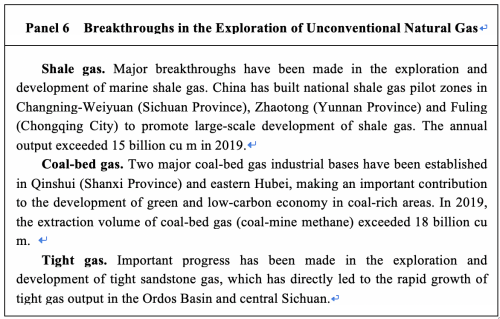
Raising the level of oil exploration, development and processing. China has strengthened domestic oil exploration and development, furthering related institutional reforms and promoting scientific and technological R&D and the application of new technologies. It has intensified the exploration and development of low-grade resources, and increased crude oil reserves and production. It has developed advanced oil recovery technologies, increased the recovery ratio of crude oil, and ensured steady output at old oilfields in the east, including the Songliao and Bohai Bay basins. Focusing on the Xinjiang region and the Ordos Basin, it has increased the reserves and production of new oilfields in the west of the country. It has also strengthened offshore oil and gas exploration and development in the Bohai Sea, the East China Sea and the South China Sea, and are advancing deep-sea cooperation with other countries. The output of offshore oilfields was about 40 million tons in 2019. China is also transforming and upgrading its oil refining industry to produce better refined oil products and improved fuel quality, which will reduce exhaust gas pollution of vehicles.
3. Improving the Energy Storage, Transportation and Peak-Shaving System
China coordinates the transportation of various energy resources such as coal, electricity, oil, and gas. It has built interconnected transmission and distribution networks and established a stable and reliable energy storage, transportation and peak-shaving system, to enhance its emergency response.
Strengthening energy transmission and distribution networks. China has been building cross-provincial and cross-regional key energy transmission channels, to connect major energy producing and consumption regions, and promote the complementary and coordinated development between regions. It has improved the capacity of existing railway lines for transporting coal, and seen that more coal is transported by rail with higher efficiency. It has enhanced the connectivity between main natural gas pipelines and provincial pipelines, liquefied natural gas receiving terminals, and gas storages, and is building a unified national network. A natural gas transportation system that is flexible, safe and reliable has taken shape. China has steadily built trans-provincial and trans-regional power transmission channels, and expanded the scope of clean energy allocation in the northwest, north, northeast and southwest. It has improved the main framework of the regional power grid and strengthened internal grid building at the provincial level. It has also carried out flexible HVDC pilot projects, and is working on the Internet of Energy (IoE) and a multilevel power system that is safe, reliable, and of a reasonable size.
Improving energy reserves for emergency response. China has integrated state, corporate, strategic and commercial reserves to achieve higher reserves for oil, natural gas and coal. It has improved the national oil reserve system and accelerated the construction of oil reserve bases. It has set up a multilevel natural gas storage and peak-shaving system, with local governments, gas suppliers, pipeline transportation enterprises and urban gas services fulfilling their respective responsibilities. It has also put in place a coal reserve system with enterprises playing the main part out of their social responsibility and local governments playing a supporting role. China has improved the national emergency mechanism for large-scale power outages, made power supply more reliable, and enhanced its emergency response. It has established a guarantee system for energy transmission and distribution that matches its energy reserve capacity, a standardized system for oil procurement, storage, replacement and use, and a supervisory mechanism for implementation.
Enhancing the energy peak-shaving system. China attaches equal importance to the supply side and the demand side. It strives to increase the peak-shaving capacity with sound market mechanism and strong technological support, so as to use the energy system in an efficient and allround way. It has accelerated the construction of pumped-storage power stations, built natural gas peak-shaving power stations as appropriate, and implemented power flexibility transformation projects in existing coal-fired CHP cogeneration units and coal-fired power generating units, so as to improve the peak-shaving performance of the power system, and promote clean energy accommodation. It is optimizing energy storage, power generation from new energy sources and the operation of the power system, and carrying out electrochemical energy storage and other peak-shaving pilot projects. It has promoted the construction of facilities for natural gas storage and peak shaving, improved the market-oriented mechanism of auxiliary services, and enhanced the peak-shaving capacity of natural gas. China has also improved its policies on electricity and gas prices to guide power and natural gas users to participate in peak shaving and peak shifting, so as to enhance the response on the demand side. It has improved the system for interrupting or adjusting electricity and natural gas load to tap the demand-side potential.
4. Supporting Energy Development in Rural and Poor Areas
China has implemented the strategy of rural revitalization to improve energy security in rural areas, so that the residents can have a better sense of gain, happiness and security.
Improving rural energy infrastructure. Making electricity accessible to all is a basic condition for building a moderately prosperous society in all respects. China implemented a three-year action plan to ensure power access for people without electricity, and had achieved this goal by the end of 2015. China attaches great importance to the renovation and upgrading of the rural power grid and makes great efforts to strengthen the weak links in the process. It has carried out targeted programs for renovating and upgrading power grid in small towns and central villages, connecting motor-pumped wells in rural plain areas to the grid, and supplying poor villages with electricity for industrial and commercial use. Since 2018, it has been focusing on upgrading the power grid in severely impoverished areas and border villages. China has built natural gas branch pipelines and infrastructure to expand the coverage of the pipeline network. To improve energy infrastructure in rural areas, it has built supply outlets for liquefied natural gas, compressed natural gas, and liquefied petroleum gas in areas not covered by natural gas pipelines, and developed renewable energy sources adapted to local conditions.
Carrying out targeted poverty alleviation through energy projects. Energy is a driving force for economic development, and also an important impetus for poverty alleviation. China makes sound plans for the exploitation of energy resources in poor areas, introducing major energy projects in these areas to improve their capability to sustain themselves, thus adding new momentum to the local economy. It has given priority to energy development projects in old revolutionary bases, ethnic minority areas, border areas and poor areas, and built power transmission bases for sending surplus clean electricity to other parts of China, contributing significantly to local economic growth. In developing hydropower, China has followed a sustainable development path by ensuring smooth relocation and resettlement of residents, and by making sure those involved have the means to better themselves, so that the poor share more of the benefits of resource development. China has also increased financial input and policy support for clean energy such as biomass, wind power, solar power, and small hydropower stations in poverty-stricken areas. It has adopted various models integrating solar PV power and agriculture to reduce poverty, and built thousands of "sunshine banks" in poor rural areas.
Using clean energy for heating in rural areas in north China. Winter heating is of great importance in northern China. To ensure that the residents stay warm in winter while reducing air pollution, China has launched clean heating programs in rural areas in accordance with local conditions. In this new scheme enterprises assume the main responsibility and governments provide support to ensure affordable heating for the people. China has been steadily replacing coal with electricity and natural gas for centralized heating, and supported the application of clean biomass fuel, geothermal energy and solar energy in heating, as well as the use of heat pumps. At the end of 2019, the rate of clean-energy heating in the rural areas of north China was about 31 percent, up 21.6 percentage points from 2016. By 2019 about 23 million households in rural areas in northern China had replaced bulk coal with clean energy, including 18 million households in the Beijing-Tianjin-Hebei region, its surrounding areas and the Fenhe-Weihe River Plain.
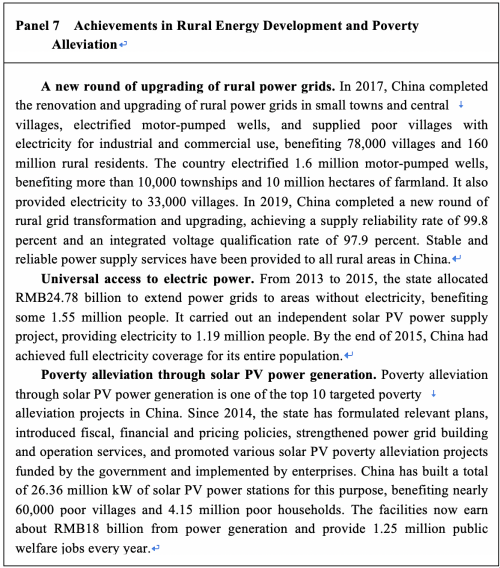
V. Leveraging the Role of Innovation as the Primary Driver of Development
China has seized the opportunities presented by the new round of scientific and technological revolution and industrial transformation. In the energy sector, it has implemented a strategy of innovation-driven development to increase its capacity for scientific and technological innovation and address major issues and challenges, such as energy resource constraints, environmental protection, and climate change, through advances in technology.
1. Improving Top Level Design for Energy Policies Relating to Scientific and Technological Innovation
China has made energy a vital part of its innovation-driven development strategy, and given more prominence to innovation in energy science and technology. Modern energy technology that is safe, clean and of high efficiency is a key strategic sector and a national priority in the country's "Outline of Innovation-driven Development Strategy". Accordingly China has drawn blueprints for sci-tech innovation in energy and resources, made strategic plans for scientific and technological development of the resources and energy industry till 2035, and proposed major measures and tasks for innovation in energy science and technology. These are all aimed to enhance the role of scientific and technological innovation in driving and underpinning the energy sector.
By making plans for technological innovation in energy and creating the "Innovation Action Plan of Energy Technological Revolution (2016-2030)", China has charted the roadmap and identified its priorities. Through deeper reform, China is establishing an energy science and technology system in which technological innovation is directed by the government and led by the market, and engages the whole of society, with enterprises playing a major role and all stakeholders coordinating with each other. At the same time China has increased investment in scientific and technological innovation in key energy fields and emerging energy industries, stepped up efforts to cultivate professionals in these areas, and endeavored to help all entities involved to improve their capacity for innovation.
2. Creating Diversified Platforms for Technological Innovation in Energy at Various Levels
On the strength of leading enterprises, research institutions and universities, China has created a number of high-standard platforms for technological innovation, and inspired enthusiasm for innovation among all parties involved. Amid efforts to promote scientific and technological advances in energy, China has established more than 40 key national laboratories and a group of national engineering research centers that focus on research into technologies for safe, green and intelligent coal mining, highly efficient use of renewable energy, energy storage, and decentralized energy systems. It has also built more than 80 national energy R&D centers and key national energy laboratories for research in the key areas of coal, oil, natural gas, coal-fired power, nuclear power, renewable energy and energy equipment, all of which cover the vital and frontier areas of energy innovation. Adapting to their own needs and the needs of the industry, large energy enterprises have made continuous efforts to build up their scientific and technological capacity, and have established some influential research institutions in their respective fields. In keeping with the industrial strengths of their regions, local governments have adopted various measures to expand their scientific and technological capacity. Encouraged by the policy of "public entrepreneurship and public innovation", all entities in Chinese society are actively engaged in scientific and technological innovation, and a large number of new energy technology businesses have been established.
3. Promoting Coordinated Scientific and Technological Innovation in Key Realms of the Energy Sector
China has implemented major scientific and technological initiatives and projects to achieve leapfrog development in key energy technologies. Focusing on its strategic industrial goals, China has rolled out a project on oil and gas technology whose emphasis is making breakthroughs in petroleum geology theory and key technologies for high-efficiency exploration and exploitation, as well as finding technology solutions to low-cost, high-efficiency exploitation of unconventional sources of energy, including shale oil, shale gas and gas hydrates. China has launched a project in nuclear power technology to advance research on core technologies of a third-generation pressurized water reactor and a fourth-generation high-temperature gas cooled reactor. The goal is to boost the country's independent innovation in nuclear power technology. In the field of key generic technologies, China has planned for and carried out research into new energy vehicles, smart grid, smart coal mining, clean and efficient use of coal and new energy-saving technology, renewable energy and hydrogen energy, among others. To achieve its major strategic goals, China has given priority to research in basic physics and chemistry concerning clean and efficient use and conversion of energy, in the hope that advances in basic research will lead to breakthroughs in applied technologies.
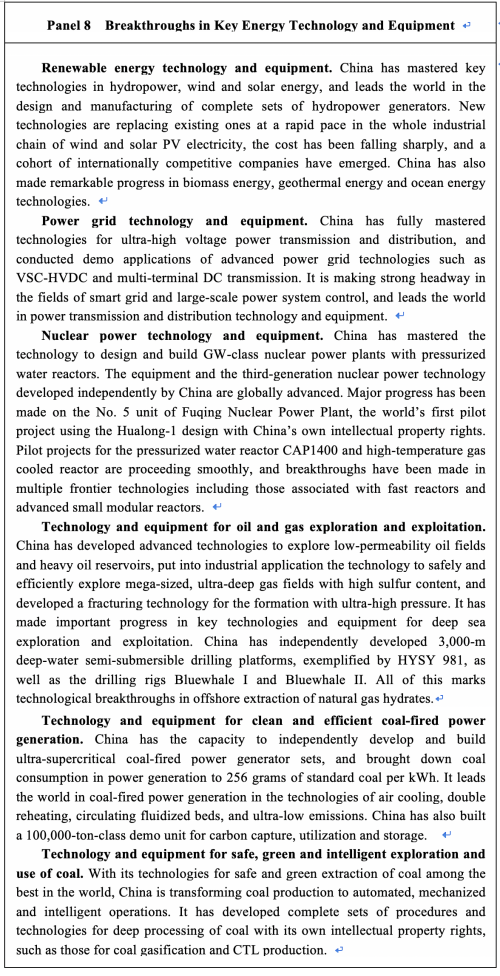
4. Launching Major Energy Projects to Upgrade Energy Technologies and Equipment
In a global trend of transition to green and low-carbon development in the energy sector, China has accelerated the upgrading of conventional energy technologies and equipment, and is replacing them with new ones at a faster pace. It has redoubled efforts to make independent innovations in emerging energy technologies, and achieved a marked improvement in clean, low-carbon energy technologies. By launching major equipment manufacturing projects and major demonstration projects, China has made breakthroughs in the trials, demonstration, application and popularization of key energy technologies. It has improved the measurement, standard setting, testing, and certification systems of energy equipment, and built up its capacity to research, develop, design and manufacture complete sets of important energy equipment.
To achieve secure energy supply, develop clean energy, and encourage the clean, efficient use of fossil fuels, China concentrates on making breakthroughs in key technologies in energy equipment manufacturing, solving bottleneck issues involving materials and accessories, and promoting technological innovation along the whole industrial chain. China has launched major demonstration projects for advanced energy technologies and equipment in such fields as clean and intelligent coal mining, washing and selection, the exploration and exploitation of deep-water and unconventional oil and gas resources, oil and gas storage and transport, clean and efficient coal-fired power generation, advanced nuclear power technologies, power generation from renewable sources, gas turbine, energy storage, advanced power grid, and deep processing of coal.
5. Supporting the Development of New Technologies and New Business Forms and Models
The world now stands at the confluence of a new round of technological revolution and an industrial revolution. New technological breakthroughs have accelerated industrial transformation, giving rise to waves of new business forms and models in the energy sector. China has made strenuous efforts to integrate energy technologies with modern and advanced information, material and manufacturing technologies, and has rolled out the "Internet +" intelligent energy program to explore new models of energy production and consumption. It has stepped up efforts to innovate and upgrade intelligent solar PV power generation, integrate the development of solar PV power generation with agriculture, fishery, animal husbandry and construction, and open new space for the complimentary application of solar PV power generation, creating new models in the utilization of new energy.
China has picked up its pace in developing industrial chains in the production, storage, transport and application of green hydrogen, hydrogen-fuel cells, and hydrogen-powered vehicles. It supports the application of
energy storage technologies at multiple points in energy production and
utilization, and the complementary development of energy storage and renewable energy. By supporting the construction of micro-grids for new energy, China has established regional systems of clean energy supply that integrate power generation, storage and utilization. It promotes new
comprehensive energy services and strives for complementary, coordinated
and efficient end use of various forms of energy. With pilot and demonstration projects leading the way, a series of new energy technologies and new business forms and models have emerged, triggering a fusion of
innovative development in China's energy sector.
VI. Deeper Reform of the Energy System in All Areas
China will fully leverage the decisive role of the market in allocating energy resources, and ensure the government better play its part in this regard. It will extend market-oriented reform in key areas and on vital issues to remove institutional barriers, solve the problem of an incomplete market system, provide strong institutional guarantees for China's energy security and boost the high-quality development of the energy sector.
1. Creating an Energy Market with Effective Competition
China is working hard to cultivate a variety of market entities, break up monopolies, ease market access, and encourage competition. It is building an energy market system that is unified, open, competitive and yet orderly, removing market barriers, and making the allocation of energy resources more efficient and fairer.
Diversifying market entities. China supports a variety of market entities to operate in segments of the energy sector that are not on the entry negative list, in accordance with the law and on equal footing. China has extended systemic reform of oil and gas exploration and exploitation and opened up the market in this regard. It has implemented competitive trading of oil and gas exploration blocks, and adopted a more rigorous exit mechanism for oil- and gas-bearing zones. China encourages qualified enterprises to import crude oil. It has reformed the oil and gas pipeline operation system to separate transport from sales. In an effort to reform electricity distribution, China is opening up electricity distribution and sales to non-government investment in an orderly manner, and is separating power grid enterprises' secondary business from their core business. New market entities are being cultivated in the fields of electricity distribution and sales, energy storage, and comprehensive energy services. Meanwhile China is extending reform of energy SOEs, supporting development of the non-public sector, and conducting active yet prudent mixed-ownership reform in the energy industry to boost the vitality and motivation of energy enterprises.
Building an energy market system that is unified, open, and competitive yet orderly. China has established trading platforms for coal, electricity, petroleum and natural gas to facilitate interaction between demand and supply. A modern coal market system is under construction. Futures trading of thermal coal, coking coal and crude oil and spot trading of natural gas are under way. Restrictions have been lifted on the generation and consumption of electricity by commercial consumers. An electricity market is under way to incorporate medium- and long-term trading, spot trading and other forms of trading of electricity. China is also working to build a unified electricity market across the country and a national carbon emissions trading market.
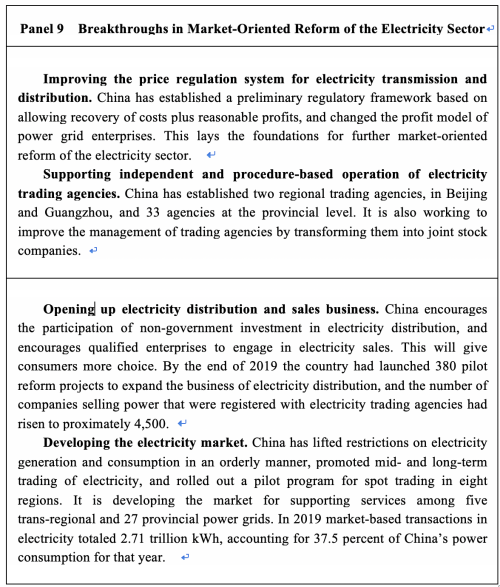
2. Improving the Market-Based Mechanism for Deciding Energy Prices
Following the principle of "allowing for more competition in electricity generation, sales and consumption while tightening government regulation of power grid, transmission and distribution", China has lifted price control over competitive areas and links. The goal is to allow prices to reflect market demand, and thereby guide the allocation of resources. It has also conducted strict government oversight of the determination of pricing to cover reasonable costs.
Lifting price control over competitive links in an orderly manner. China is steadily fostering a market-based pricing mechanism of commercial electricity generation and distribution, and allowing prices to be decided by electricity users, sellers and producers through market-based modalities. China has extended reform of the price-setting mechanism for on-grid electricity from coal-fired power plants, and introduced a market-based pricing mechanism in which electricity prices may fluctuate above or below the benchmark. Steady progress has been made in determining the price of on-grid electricity from new wind and solar PV power plants through competitive bidding. Relevant parties are encouraged to negotiate on the basis of sharing risks and benefits, and set through market-based modalities the price for trans-provincial or trans-regional transmission of electricity. The pricing mechanism for oil products is being improved. Reform is ongoing in having the market determine gas prices. China has enforced progressive pricing for household consumption of electricity and gas across the nation, ensuring basic living needs are met while encouraging conservation.
Appropriately deciding prices for natural monopoly operations. Allowing recovery of costs plus reasonable profits, China has set appropriate transmission and distribution prices for power grids and gas pipelines. It has analyzed costs and verified prices for electricity transmission and distribution over two regulatory periods. China has also stepped up the price regulation of gas transmission and distribution and analyzed gas costs in order to establish a price regulation system that covers the whole process of gas transmission and distribution.
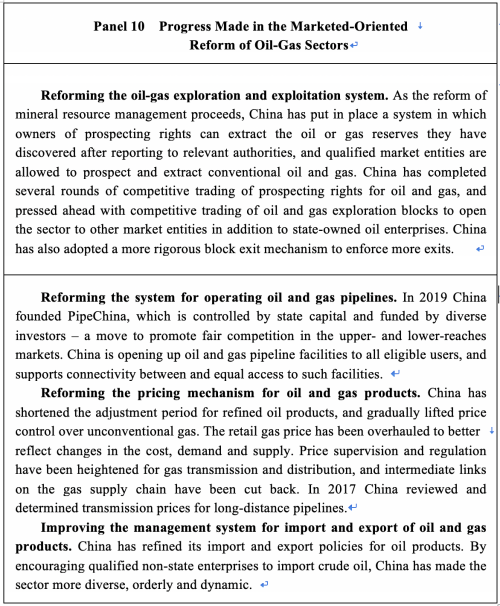
3. Innovative Management of the Energy Sector and Improved Government Services
Working to become a service-oriented government, the Chinese government has further transformed its functions, streamlined administration, delegated powers, improved regulation and upgraded services. It employs strategic plans and macro-policies on energy, and mobilizes resources for major undertakings. Better oversight and regulation of the energy market will deliver better results and promote fair competition among all market entities. Putting people and lives above everything else, China has remained firm in its commitment to safe production in the energy industry.
Igniting the vitality of market entities. China has extended reform in the energy sector to delegate powers, improve regulation, and upgrade services. This includes reducing approval by the central government for energy projects and delegating the approval power to local authorities for some projects. The requirement for government review and approval has been rescinded for energy projects about which market entities can decide at their own discretion. The number of items of preliminary review has been slashed and the threshold for market access has been lowered, while supervision during and after production has been enhanced and standardized. "Access to electricity" services have been improved. As a result the time, procedures and cost needed for businesses to connect to the power grid have all been cut down. In addition, China has promoted the "internet plus government services" model, and expanded the practice of providing all energy-related government services at one simple window in localities where all relevant authorities have outlets, thereby improving one-stop services.
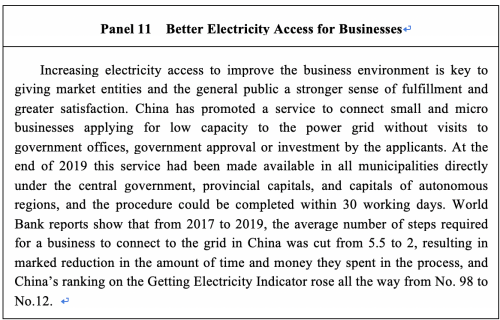
Guiding the allocation of resources. In addition to other plans, including special plans and action plans, China has drawn up and implemented the "Strategy for Energy Production and Consumption Revolution (2016-2030)" for developing the energy sector. These define the overall goals and key tasks, and guide investment in the sector. In order to encourage market entities to appropriately explore and utilize energy resources, China has refined its fiscal, taxation, industrial, financing, and investment policies, implemented a nationwide ad valorem tax on crude oil, natural gas and coal, and raised excise tax on oil products. It is building a green finance incentive system to promote new energy vehicles and develop clean energy. China also encourages Renminbi settlement for trading in bulk energy commodities.
Promoting fair competition. China has overhauled the government's regulatory power and responsibilities, and gradually transformed regulation of the electricity sector to comprehensive regulation of the entire energy sector. It has tightened regulation of electricity transaction, distribution and supply, the market order, equitable connection to the power grid, and grid investment, cost and efficiency. China has also reinforced oversight of the opening of oil and gas pipeline facilities to all eligible users, increased information transparency of pipeline operators, and increased the utilization rate of these facilities. Random inspection by randomly selected staff and prompt release of inspection results have been expanded to the whole energy sector. Efforts have been intensified to establish a credit system in the energy industry, created in accordance with law lists of entities that have committed serious acts of bad faith, and to take joint punitive action against such acts, hence increasing the effectiveness of credit regulation. China exercises prudential regulation of new business forms to develop new drivers of growth. It also keeps energy hotlines open to ensure oversight by the public.
Ensuring production safety. China has improved the accountability system for coal mine safety, raised the efficiency of coal mine supervision,
regulation and law enforcement, created a standardized management system for coal mine safety, and built up its capacity for disaster prevention and control. As a result coal mine safety has much improved. Enterprises share the main responsibility for power safety, industry regulators share the regulatory responsibility, and local authorities have the overall responsibility for safety in their respective jurisdictions. Oversight and management have been improved to ensure cybersecurity of the electricity system, as well as the safety and quality of electricity construction projects. Safety risks in the supply of electricity are manageable in general, and there has been no instance of extensive blackout. Meanwhile, through stronger safety regulation of the entire oil and gas industrial chain, China has maintained safety in oil and gas production. Thanks to sustained efforts to improve its system and capacity for nuclear safety regulation, China's nuclear power plants and research reactors are generally safe and secure, and the quality of nuclear projects under construction is well controlled as a whole.
4. Improving the Rule of Law in the Energy Sector
Implementation of the rule of law is essential in the energy sector. It stabilizes expectations and creates long-term benefits. China aligns law making with reform and development in the energy industry, and has amended or abolished laws and regulations incompatible with the needs of reform and development in the sector. China adheres to the principle that administrative bodies must fulfill their statutory obligations and must not take any action that is not mandated by law, and sees that the government fully performs its functions in accordance with the law.
Improving the system of energy laws. More laws and administrative regulations concerning the energy sector have been formulated or amended. Supervision and inspection of the enforcement of energy laws and regulations has been intensified. The work to enact, amend or repeal regulations and normative documents in the fields of electricity, coal, oil, natural gas, nuclear power and new energy has been accelerated, in order to incorporate reform results into China's laws, regulations and major policies.
Improving law-based governance of the energy sector. China is working to ensure law-based governance and see that the rule of law materializes in the entire process of making, enforcing, overseeing and managing energy strategies, plans, policies and standards. To raise awareness of the law, it is developing a new paradigm that features interaction and mutual support between the government and enterprises, which will help create an enabling environment across the nation for respecting, studying and observing the law. China has adopted new practices in administrative law enforcement by introducing a nationwide system for disclosing information on administrative law enforcement, a system for recording the entire enforcement process, a system for reviewing the legality of major enforcement decisions, and an accountability system. China will ensure that the channels for applying administrative reconsideration and filing administrative lawsuits remain open, that cases are handled in accordance with laws and regulations, that the legitimate rights and interests of administrative counterparts are protected in accordance with the law, and that people can see in every case that justice has been served.
VII. Strengthening International Energy Cooperation Across the Board
China bases international cooperation on the principle of mutual benefit and win-win results while embracing the concept of green development. It is endeavoring to ensure energy security in an open environment, open its energy sector wider to the world, promote high-quality Belt and Road cooperation, actively engage in global energy governance, guide global cooperation in climate change, and build a global community of shared future.
1. Opening the Energy Sector Further to the World
China is committed to a stable global energy market and is opening its energy sector wider to the world. It has greatly eased market access for foreign investment, and has built a market-based international business environment that respects the rule of law to facilitate free trade and investment. It has adopted pre-establishment national treatment plus a negative list, reducing restrictions on access to the energy sector for foreign investment. It has lifted the restrictions for foreign investment to enter the sectors of coal, oil, gas, electric power (excluding nuclear power), and new energy. It is promoting the energy industry in pilot free trade zones such as Guangdong, Hubei, Chongqing and Hainan, and supports further opening up of the entire oil and gas industry in the China (Zhejiang) Pilot Free Trade Zone. International energy companies such as ExxonMobil, GE, BP, EDF and SIEMENS are steadily expanding investment in China. Major foreign investment projects such as Tesla's Shanghai plant are well under way. Foreign-funded gas stations are spreading.
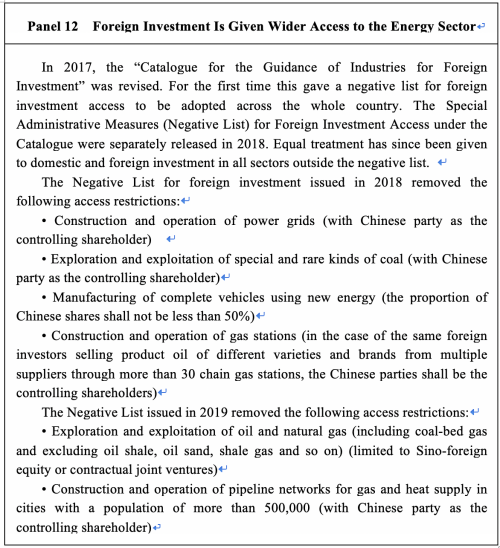
2. Promoting Energy Cooperation Among BRI Countries
China follows the principles of extensive consultation, joint contribution and shared benefits, and pursues open, green and clean governance in its energy cooperation with BRI countries towards high-standard, people-centered and sustainable goals. It attempts to bring benefits to more countries and their people while maintaining its own development trajectory, and to create conditions favorable to further common development.
Pragmatic and mutually beneficial energy cooperation. China engages in extensive cooperation with over 100 countries and regions around the world in terms of energy trade, investment, industrial capacity, equipment, technology, and standard setting. The high standards of Chinese enterprises are much sought after by partner countries for their energy projects, which help to turn local resource advantages into development strengths. They will also drive technical progress in these countries, create more jobs, stimulate the economy, and improve people's lives. In this way China and its BRI partners will grow together by leveraging and incorporating their respective strengths. China builds cooperation with countries and large transnational corporations in the field of clean energy through third-party markets, to create an energy cooperation framework which is open, transparent, inclusive, and mutually beneficial. In 2019, China established Belt and Road energy partnerships with 30 countries.
A silk road with green energy. China is the largest renewable energy market and the largest clean energy equipment manufacturer in the world. It is actively working towards green and low-carbon global energy transition by engaging in extensive cooperation in renewable energy. Its efforts can be seen in cooperation projects such as the Kaleta hydropower project in Guinea, the Kaposvar PV power station project in Hungary, the Mozura wind park project in Montenegro, Noor Energy 1 – the CSP+PV solar power project in Dubai of the UAE, the Karot hydropower project and the first phase of the solar PV power project in the Quaid-e-Azam Solar Park in Pakistan. The wide application of renewable energy technologies in the Chinese market is helping to reduce the cost of renewable energy across the globe and accelerate the green transition process.
Greater energy infrastructure connectivity. China is promoting transnational and cross-regional energy infrastructure connectivity, creating conditions for complementary cooperation and reciprocal trade in energy resources. A batch of landmark energy projects such as the China-Russia, China-Central Asia and China-Myanmar oil and gas pipelines have been completed and brought into operation. China has now connected its grid with the power grids of seven neighboring countries, giving a strong boost to energy infrastructure connectivity and realizing optimal allocation of energy resources on a larger scale, which facilitates economic cooperation within the region.
Wider global energy access. China actively implements the UN sustainable development goal of ensuring "access to affordable, reliable, sustainable and modern energy for all". It also takes an active part in global cooperation on expanding energy access. To improve energy access in partner countries and benefit ordinary people, China has employed multiple financing methods to develop electric power projects using grid-connected, microgrid, or off-grid solar systems according to local conditions, and donated clean cooking stoves to regions still using traditional cooking fuels.
3. Actively Participating in Global Energy Governance
As a staunch supporter of multilateralism, China builds bilateral and multilateral energy cooperation based on mutual benefit and win-win results. It supports the role of the International Energy Agency (IEA) and relevant cooperation mechanisms in global energy governance, promotes global energy market stability and supply security, and the green energy transition within the framework of international multilateral cooperation, and contributes ideas and solutions to the sustainable development of global energy.
Engagement in multilateral energy governance. China is an active participant in international energy cooperation under multilateral mechanisms such as the UN, G20, APEC and BRICS. It is making positive progress in joint research, releasing reports and founding agencies. China has set up intergovernmental energy cooperation mechanisms with over 90 countries and regions, and established ties with over 30 international organizations and multilateral mechanisms in the energy sector. Since 2012, China has become a member state of the International Renewable Energy Agency (IRENA), an observer country to the Energy Charter Treaty, and an affiliate of the IEA.
A facilitator in regional energy cooperation. China has built regional energy cooperation platforms with ASEAN, the League of Arab States, African Union, and Central and Eastern Europe, and organized forums on clean energy at the East Asia Summit. It has also facilitated capacity building and cooperation on technological innovation and provided training for 18 countries in clean energy use and energy efficiency.
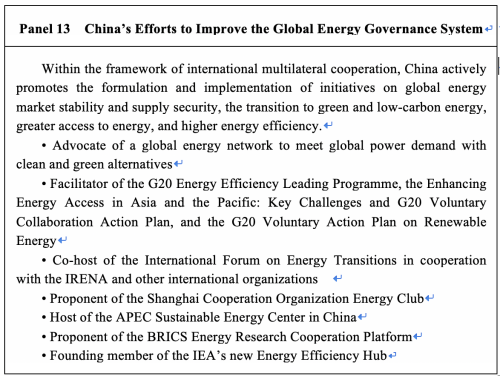
4. Joining Forces to Tackle Global Climate Change
Embracing the vision of a global community of shared future, China works together with other countries to address global climate change and promote the transition to green and low-carbon energy.
Strengthening international cooperation on climate change. With support from the UN, World Bank, Global Environment Facility, Asian Development Bank, and countries such as Germany, China is focusing on green and low-carbon energy transition and developing extensive and sustainable bilateral and multilateral cooperation with other countries in exploiting renewable energy and showcasing pilot low-carbon cities through experience sharing, technical exchanges, and project dovetailing.
Supporting capacity building in developing countries to address climate change. China is committed to deeper South-South climate cooperation. It provides support to the least developed countries, small island countries, African countries and other developing countries in their response to climate change. Since 2016, China has set up 10 pilot low-carbon
industrial parks, launched 100 mitigation and adaptation programs, and provided 1,000 training opportunities on climate change cooperation in developing countries to help them develop clean and low-carbon energy and jointly address global climate change.
5. China's Proposals for Developing Synergy on Sustainable Global Energy Development
Humanity has entered an era of connectivity when maintaining energy security and addressing global climate change have become major challenges confronting the whole world. The ongoing Covid-19 pandemic highlights all the more the interdependent interests of all countries and the interconnection of all peoples. China proposes that the international community should work together on the sustainable development of global energy, address the challenges of climate change, and build a cleaner and more beautiful world.
Jointly promoting the transition to green and low-carbon energy to build a cleaner and more beautiful world. It requires the joint effort of all countries to address the challenge of climate change and improve the global eco-environment. All countries should choose the green development path, adopt green, low-carbon and sustainable working practices and lifestyles, promote energy transition, and address problems relating to energy. We should join forces to tackle global climate change and make our contribution to building a cleaner and more beautiful world.
Jointly consolidating multilateral energy cooperation to accelerate the green economic recovery and growth. We should improve international governance and maintain an open, inclusive, balanced and reciprocal multilateral framework for international energy cooperation. We should expand communication and pragmatic cooperation in the energy sector to promote economic recovery and integrated development. We should strengthen transnational and cross-regional innovation on clean-energy and low-carbon technologies, and cooperation on technology standards, to promote energy technology transfer and rollout and improve international IPR protection.
Jointly facilitating international investment in energy trading to protect global market stability. We should eliminate energy trade and investment barriers, facilitate trade and investment, cooperate on energy resources and industrial capacity as well as infrastructure, improve connectivity, and promote efficient resource allocation and greater market integration. We should embrace the principles of extensive consultation, joint contribution and shared benefits, seek the greatest common ground to promote the sustainable development of global energy, and jointly maintain global energy security.
Jointly improving energy access in underdeveloped areas to address energy poverty. We should join forces to realize the sustainable goal in the energy sector, and ensure access to basic energy services such as electricity for people in need in underdeveloped countries and regions. We should help underdeveloped countries and regions to popularize advanced green energy technologies, train energy professionals and improve energy services to integrate the efforts on green energy development and the elimination of energy poverty.
Conclusion
China is embarking on a new journey towards a modern socialist country in all respects. In this new development stage, it will remain committed to an energy revolution, and move faster to build a clean, low-carbon, safe and efficient energy system, to lay a solid foundation for basically achieving socialist modernization in 2035 and becoming a great modern socialist country by the middle of the 21st century.
The world today is experiencing a scale of change unseen in a century. The eco-environment has a direct bearing on human existence and its sustained development. Countries of the world need to work in solidarity to cope with the challenge. China will embrace the vision of a global community of shared future, work together with all countries to expand cooperation on global energy governance, promote the sustainable development of global energy, and protect global energy security. This is part of our commitment to realizing more inclusive, balanced and equal development for all, and to building a clean, beautiful, prosperous and habitable world.
























